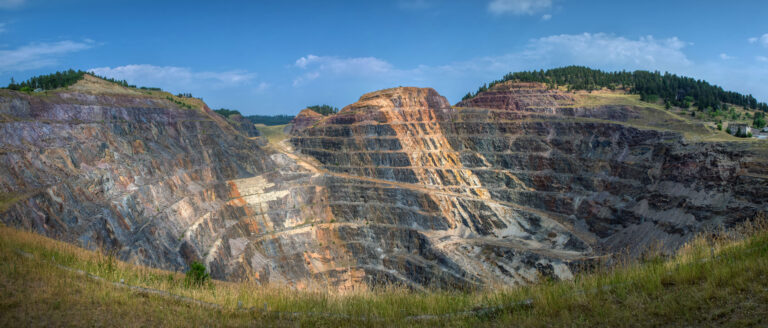When gold was discovered on French Creek near present-day Custer in 1874, miners descended upon the Black Hills in search of fortune. Initial pickings were slim, prompting them to expand their efforts in the northern Hills. The Black Hills Gold Rush kicked into high gear with the discovery of placer gold in a canyon littered with dead trees that came to be known as Deadwood Gulch. These loose gold flakes are secondary deposits from lode-bearing ore, and prospectors fanned out from Deadwood in search of its source. On April 9, 1876, brothers Fred and Moses Manuel and two other prospectors, Hank Harney and Alex Engh, found a significant vein of gold in a rocky outcropping three miles south of Deadwood. They staked a claim and named it the Homestake Mine, having no idea they had discovered the literal mother lode of all that gold washing into Deadwood and Whitewood Creeks. Homestake would turn out to be one of the most prolific gold-producing mines in the world.
When the town that sprang up around the mine officially incorporated on July 10, 1877, it was named for the veins of gold known as “leads” (pronounced LEED). The Manuel brothers had mined about $5,000 worth of gold that first year before selling to a group of out-of-state investors, led by businessman and miner George Hearst, for $70,000 in 1877. He consolidated a number of smaller mining claims into one operation he named the Homestake Mining Company, and Lead became the quintessential company town. Lead was considerably more civilized than its sister city, Deadwood, thanks in large part to the influence of George’s wife, Phoebe. Though the couple didn’t spend much time in Lead, Phoebe created the Hearst Free Public Library and the Hearst Free Kindergarten, was instrumental in helping establish the Homestake Opera House, and gave back to the community through regular financial contributions that benefited churches, students, and miners.
The Homestake Mine ensured economic prosperity for Lead, but the town still struggled through difficult periods. Mining accidents were common, and the 1918 Spanish flu pandemic hit the region hard. When World War II broke out, mining operations were suspended by a decree from the War Production Board, which sought to expand industries for the war effort while suspending those deemed non-essential. Lead’s population fell sharply as many miners signed on for military duty or went elsewhere to work in copper mines. Those who remained behind worked to produce tools, airplane parts, and hand grenades. Once the war ended, mining resumed. Homestake would continue to operate until 2002; by the time it closed down for good, it was the largest and deepest gold mine in North America, with approximately 370 miles of tunnels located 8,000 feet below the surface. Over the course of its 125-year history, the mine produced 40 million troy ounces of gold.
When an industry so closely associated with a town’s fortunes ceases production it can cause worry, but Lead successfully pivoted from mining to scientific research when Homestake was selected as the sit of the Deep Underground Science and Engineering Laboratory by the National Science Foundation in 2007. An underground lab had been established in the mine in the 1960s to observe solar neutrinos, subatomic particles that pass through matter effortlessly. This was known as the “Homestake experiment” and laid the groundwork for the Sanford Underground Research Facility (SURF). Sanford Laboratories conducts a number of ongoing scientific experiments from deep within the former mine involving neutrinos, the search for dark matter, and more. The thousands of feet of rock serve as a shield from background interference, making Homestake an ideal location for this research.
Today, Lead is a popular stop for visitors to the northern Hills. It pays homage to its mining past while offering cultural opportunities and some of the area’s most beloved annual events.
Learn More
For more information on attractions and events in Lead, visit us here.

